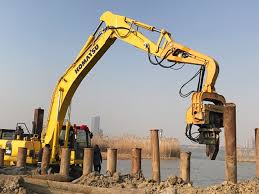The Working Principle of Excavator Mounted Vibratory Hammers Explained

In the realm of deep foundation construction and pile driving, efficiency and precision are critical. Whether it’s for temporary shoring, foundation piling, or sheet pile installation, contractors seek tools that offer power, adaptability, and speed without sacrificing safety. One such solution gaining popularity across various civil and infrastructure projects is the use of excavator mounted vibratory hammers.
These machines combine the mobility of an excavator with the driving force of a vibratory hammer, offering a compact and cost-effective alternative to traditional crane-based systems. Understanding how they work is essential for contractors, equipment operators, and project engineers who want to optimize their operations and ensure high-quality outcomes. In this article, we’ll take a deep dive into the working principle of excavator mounted vibratory hammers and explore why they are becoming indispensable on modern job sites.
What Are Excavator Mounted Vibratory Hammers?
Excavator mounted vibratory hammers are specialized attachments that can be mounted on the arm of standard hydraulic excavators. Their primary function is to drive or extract piles by using high-frequency vibration. These hammers are engineered to convert the hydraulic power of the excavator into vertical vibrations, which reduce the friction between the pile and the surrounding soil, allowing the pile to be driven or extracted more easily.
The advantage of mounting a vibratory hammer on an excavator is the mobility and versatility it brings. Operators can move quickly between pile locations without needing additional lifting equipment, and the entire system is more compact and suitable for working in confined spaces, such as urban job sites or under bridges.
The Core Components
To understand the working principle, it’s important to first examine the key components that make up an excavator mounted vibratory hammer:
-
Eccentric Weights – Located inside the hammer, these rotating masses generate vibration. By spinning in opposing directions, they produce vertical oscillations that are transferred to the pile.
-
Hydraulic Motor – Powered by the excavator’s hydraulic system, the motor drives the rotation of the eccentric weights.
-
Clamp Mechanism – The clamp securely grips the pile (whether it is steel, sheet, or timber) during driving or extraction. It is usually hydraulically controlled for easy attachment and release.
-
Excavator Mount Bracket – A specially designed adapter that connects the vibratory hammer to the excavator arm, allowing full mobility and control through the excavator’s boom and tilt functionality.
-
Vibration Isolator – This component protects the excavator from harmful vibrations by dampening the energy that would otherwise be transferred from the hammer back into the boom and arm.
How the Vibration Process Works
At the heart of the system is the creation and controlled application of vertical vibrations. The principle behind it involves the concept of vibratory driving, where continuous vibrations are used to reduce soil resistance and allow the pile to move more freely into the ground.
Here is how it works step by step:
-
Hydraulic Activation – Once the hammer is attached and positioned on the pile, the excavator operator activates the hydraulic system. This powers the motor, which begins to rotate the eccentric weights.
-
Eccentric Motion – As the counter-rotating weights spin, they produce vertical oscillations. The frequency of vibration typically ranges from 1200 to 2500 revolutions per minute, depending on the hammer model and the soil conditions.
-
Soil Displacement – The rapid up-and-down motion caused by the vibration temporarily reduces the soil’s internal friction and cohesion. Essentially, the soil behaves more like a fluid around the pile, allowing it to sink under its own weight or with a modest downward force from the excavator arm.
-
Pile Penetration – The operator maintains steady pressure, ensuring that the pile drives vertically into the ground. The vibratory force keeps soil resistance low until the desired depth or refusal is reached.
-
Extraction Process – When used for pile removal, the process is reversed. Vibrations loosen the surrounding soil, and the operator uses the excavator’s lifting capability to extract the pile vertically with minimal resistance.
Benefits of Using Excavator Mounted Vibratory Hammers
Contractors increasingly favor these tools due to several operational and economic benefits:
-
Portability – These systems eliminate the need for cranes, making them ideal for tight job sites or projects with limited access.
-
Speed – Vibration allows for faster pile driving compared to impact methods, especially in non-cohesive soils.
-
Lower Noise Levels – Compared to diesel or impact hammers, vibratory systems are much quieter, helping meet urban noise regulations.
-
Versatility – The ability to switch between driving and extracting piles without changing equipment increases jobsite efficiency.
-
Cost Efficiency – Reduced labor requirements, fewer equipment transfers, and quicker installation times lead to overall project savings.
Applications in the Field
Excavator mounted vibratory hammers are suitable for a wide range of applications:
-
Temporary Shoring – For excavation or trench protection.
-
Sheet Pile Installation – For retaining walls and flood control systems.
-
Steel and Timber Piling – For foundations in residential or light commercial buildings.
-
Marine and Bridge Work – Particularly effective in shoreline or over-water conditions where maneuverability is limited.
Factors Influencing Performance
While highly effective, several factors influence the success of pile driving with vibratory hammers:
-
Soil Type – Sandy and loose soils respond well to vibration, while dense clay or rocky soils may require more energy or different techniques.
-
Pile Type and Length – Heavier or longer piles may demand higher frequency or torque to ensure proper installation.
-
Operator Skill – Proper alignment and consistent driving force are critical to prevent pile damage or deviation from the intended path.
-
Equipment Match – The excavator’s hydraulic capacity must be compatible with the hammer’s requirements to achieve optimal performance.
Conclusion
The working principle of excavator mounted vibratory hammers lies in the efficient use of high-frequency vertical vibrations to drive or extract piles with minimal resistance. This method is particularly valuable for its speed, precision, and adaptability across diverse construction environments. By integrating the hammer with the mobility of an excavator, contractors gain a powerful and compact foundation solution that can perform reliably even in confined or challenging conditions.







Leave a Comment